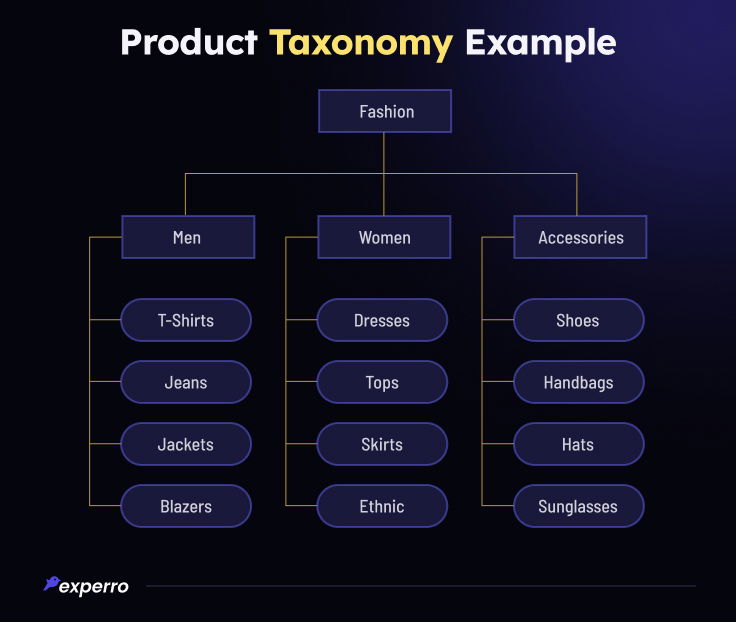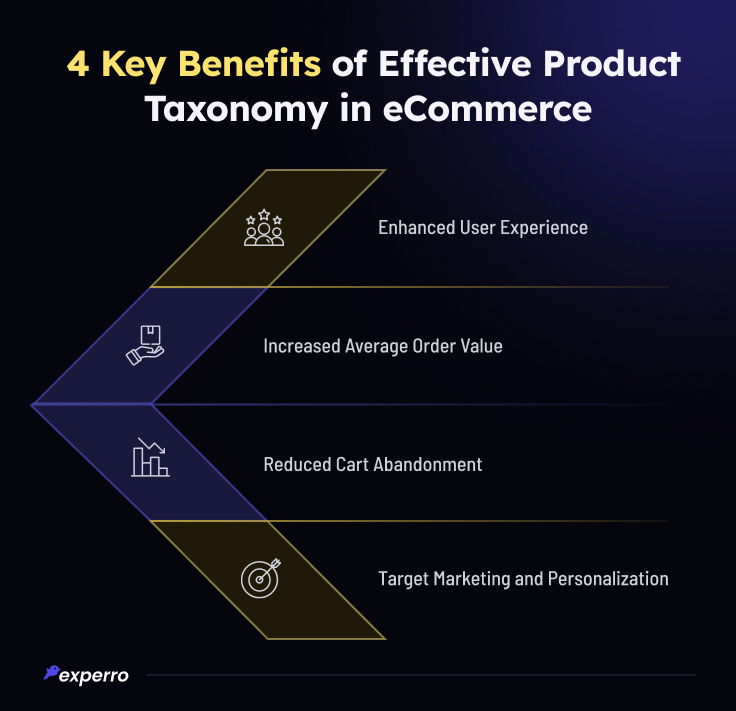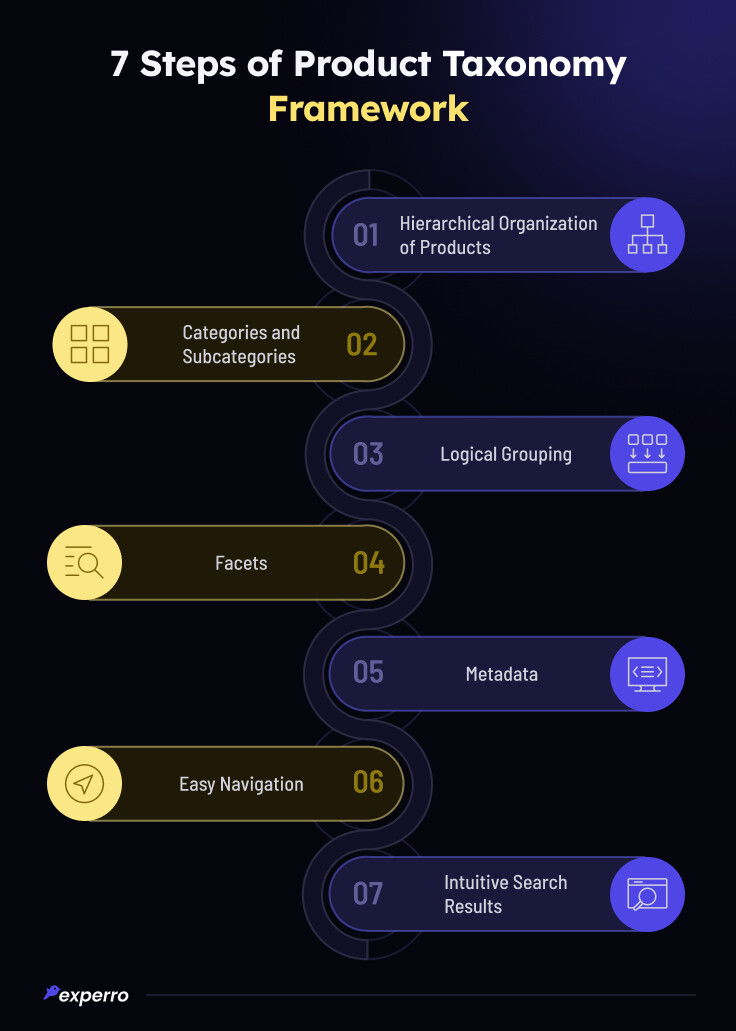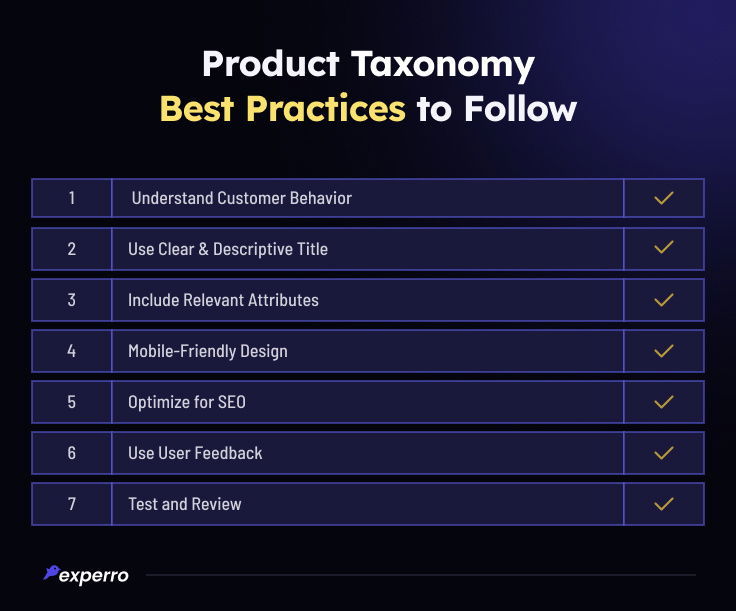Product Taxonomy: Simplify Customer Experiences & Boost Sales

What’s Inside
- What Is Product Taxonomy?
- Product Taxonomy Example
- What Are the Benefits of Effective Product Taxonomy in eCommerce?
- What is the Product Taxonomy Framework?
- What Are the Product Taxonomy Challenges & Solutions?
- What Are the Effective Product Taxonomy Best Practices?
- How Experro Elevates Product Discovery to Drive Revenue?
- Conclusion
KEY TAKEAWAYS
- Product taxonomy helps to organize items, making it easier for customers to find what they want.
- An organized product taxonomy improves SEO and helps to drive organic traffic.
- Product taxonomy simplifies and enhances customer experience.
- A well-defined product taxonomy reduces bounce rates and increases the likelihood of completing a purchase.
Have you ever wondered how your favorite online stores manage to organize their extensive product listings?
The products are smartly classified for users to find the desired results quickly.
All thanks to the strategy that simplifies the user’s eCommerce customer journey – product taxonomy!
Product taxonomy is a blueprint that enables seamless browsing experiences for customers.
It's like carefully planned product data, where every category is strategically designed to help customers find exactly what they are looking for.
In the digital context, product taxonomies are like GPS for your shopping journey.
It's a system that classifies and categorizes each item, ensuring that customers land on the right product.
In this blog, we will delve deeper into the understanding of product taxonomy, its benefits and framework and more.
What Is Product Taxonomy?
Let’s start with the Product Taxonomy definition...
Product taxonomy is a logical way of organizing a company’s digital product data based on their shared characteristics and product attributes.
Its hierarchical structure helps in classifying products into logical groups, making it easier for customers to navigate products.
Product taxonomy strategy is the organizational backbone for eCommerce websites, ensuring that every item finds its rightful place in the digital storefront.
By employing a better product taxonomy strategy, businesses can create a structured and intuitive browsing experience for customers.
This not only helps with better product discovery but also aids in enhanced eCommerce customer experience and boosts sales.
Product Taxonomy Example

Let's understand with the example of product taxonomy of an eCommerce business.
Such retail product taxonomy structure helps customers navigate the clothing store's website by providing clear categories and subcategories for different types of apparel.
It also includes attributes like size, color, and brand to assist with filtering and finding specific clothing items.
What Are the Benefits of Effective Product Taxonomy in eCommerce?

Product taxonomy has several significant benefits in the eCommerce landscape.
Some of the key benefits are as follows:
1. Enhanced User Experience
Did you know 88% of the users are not likely to return to a website after having a negative user experience!
In a competitive landscape like eCommerce, customers are presented with a multitude of choices to shop from. In that case, user experience becomes extremely important to marketers.
And when it comes to online stores, user experience is equivalent to a friendly, organized store layout.
If customers find it hard to navigate or locate products, they are likely to leave.
Effective eCommerce product taxonomy ensures that the browsing experience is intuitive and user-friendly.
It is like providing signposts in a physical store, directing customers to the right place.
This involves creating clear categories, subcategories, and filters that help customers easily navigate the products they are interested in.
2. Increased Average Order Value
Encouraging customers to explore more products to their cart significantly boosts revenue. By implementing a clear product taxonomy, businesses can display related products.
For instance, under the camera category, there could be four camera accessories, camera bags, etc.
Without the proper eCommerce taxonomy, customers might only buy one item without exploring other options.
However, offering them similar products of interest will increase the chances of purchase.
This is how the average order value can be increased by offering related products to customers.
3. Reduced Decision Fatigue
An organized taxonomy simplifies the decision-making process for customers.
When they can quickly filter and compare products within well-defined categories, they are less likely to become overwhelmed with extra choices of products.
When online websites define clear categories in product taxonomy, it becomes easier for customers to navigate the product listing.
For instance, if a product taxonomy of shoes is classified into a structured hierarchy, starting with a broad category like 'Footwear' and then breaking down into more specific subcategories, including 'Athletic Shoes' and 'Casual Shoes.'
Furthermore, these categories can comprise sub-categories like 'Running Shoes' and 'Basketball Shoes' and sneakers, loafers, and flip-flops, respectively.
This ensures that the product catalog is organized in a user-friendly manner, making it easier for customers to navigate the specific type of shoes they are looking for.
4. Target Marketing and Personalization
Personalization and target marketing help to create a tailored and relevant experience for customers.
Target marketing involves identifying specific customer segments with distinct preferences and needs.
Personalization then takes this data and tailors product recommendations, content, and marketing messages to suit each segment individually.
A company that offers personalization is likely to see a purchasing preference from 80% of consumers.
Without personalized recommendations, customers might miss out on new arrivals or specific promotions relevant to their interests.
However, a well-structured taxonomy allows businesses to analyze user behavior and preferences.
For instance, if a customer frequently browses camping equipment, the system can automatically recommend new camping gear tailored to their interest.
This leads to more effective marketing and satisfying shopping experiences.
What is the Product Taxonomy Framework?

Let's delve into the details of each aspect of the product taxonomy framework.
1. Hierarchical Organization of Products
This refers to the restructured arrangement of the product category tree in a hierarchal manner.
It's like organizing items in a store where you have departments, sections, and aisles.
In eCommerce stores, this means having main categories, subcategories, and potentially even further subdivisions.
For example, in a clothing eCommerce site, the top-level category might be apparel, which further breaks down into men's and women's apparel and then into subcategories like shirts, pants, etc.
Clear product hierarchy enables a structured layout for products, making it easier for customers to navigate the online store.
2. Categories and Subcategories
People often misunderstand categories with attributes. However, categories and attributes are different.
- Categories in product taxonomy are the main groups into which products are classified.
- Subcategories, however, are subsided within each category, which helps further refine product classification. This creates a logical and organized structure for the product catalog.
3. Logical Grouping
Logical grouping involves placing similar products together based on shared characteristics or attributes.
This helps customers quickly identify and compare products within a specific category or subcategory.
4. Facets
Facets make it easier for customers to navigate and explore a large product catalog.
They can browse through categories and then further refine their choices using facets, reducing the time and effort required to find the right product.
For instance, if a customer is shopping for shoes, they can narrow down their choices according to the filters of size 9, color black, and Brand Nike to find the exact match they are looking for.
5. Metadata
Meta descriptions provide additional information about each product. It includes details like product description, prize availability, and more.
It not only helps customers with the product information but also allows the search engine to find your website.
Product listing for a smartphone metadata would include details like model name, price availability, discount offer, etc.
6. Easy Navigation
Effective product taxonomy ensures that customers can easily navigate through the online store.
This means clear menus, intuitive links, and a user-friendly interface that guides them from a broader category to a more specific product listing.
Well-designed navigation means you should allow customers to go from the main category to subcategories with just a few clicks.
7. Intuitive Search Results
While a well-designed product taxonomy is great for enhancing user experience, one cannot overlook the importance of search functionality.
The accuracy of search results is equally important.
Want to know how?
When a customer performs a search, the system should be able to show relevant results on the base of the query. This is achieved with careful categorization and tagging of the products.
When customers find products quickly, they will be spending less time browsing and more time engaging with the product.
By implementing these elements within the product taxonomy framework, businesses can create a clear and organized structure for their online website.
This, in turn, leads to a more enjoyable and efficient eCommerce customer experience. It can benefit by driving higher revenue and customer satisfaction.
What Are the Product Taxonomy Challenges & Solutions?
The points mentioned below highlight the challenges and solutions of product taxonomy.
1. Attribute Variation
Challenge - Products often have numerous attributes. These attribute variations can be sizes, colors, materials, brands, etc. Change/update in these attributes frequently can lead to complex taxonomies. Handling these variations effectively is a challenge.
Solution – Invest in a Product Information Management (PIM) system that supports standardized data structures and ensures compliance.
2. User Experience
Challenge - Designing a taxonomy that's intuitive and user-friendly is crucial. If categories and labels are confusing, customers may struggle to find what they're looking for.
Additionally, navigation is equally important for enhancing user experiences.
If a business operates across multiple channels (e.g., website, mobile app), ensuring consistent user experience can be an issue.
Solution – Invest in a headless CMS that ensures a seamless user experience irrespective of different digital channels or devices.
3. User Behavior
Challenge - User behavior is not static; it evolves over time due to changing trends, seasonality, and influence of marketing campaigns.
Keeping up with these changes and adjusting the taxonomy accordingly requires ongoing analysis of customer behavior and patterns.
Solution – Analytics tool to identify users’ browsing journey and enables businesses to make data-driven decisions.
What Are the Effective Product Taxonomy Best Practices?

The following best practices for product taxonomy will help to create a seamless shopping experience for customers.
1. Understand Customer Behavior
Knowing your target audience's preferences and behavior is essential for creating a taxonomy that resonates with them.
Customers are always looking for an experience that resonates with their preferences and personalized needs.
Start by conducting thorough market research together with insights into your target audience. This can include demographics such as age, gender, or location or psychographics such as interest, lifetime purchasing behavior, and pain points.
TIP – Use an analytics feature offered by Experro DXP that allows businesses to gain valuable insights into customer behavior.
2. Use Clear & Descriptive Title
Clear and descriptive titles make it easier for customers to identify and understand the product categories quickly. This aids in the decision-making process and reduces confusion.
The following tips will help you to create an effective title:
- Use a title that specifically describes the content of each category to avoid overly complex or lengthy titles that may confuse the readers.
- Target keywords that website visitors are likely to search for.
- Avoid vague or ambiguous titles that could lead to confusion.
- Conduct user testing to gain knowledge on how easily users can navigate your taxonomy based on the titles.
3. Include Relevant Attributes
Attributes provide additional information about products, helping customers to make an informed decision.
It's important to select attributes that are relevant to your target market and products and align with customer preferences.
Include flexibility where products can fit into multiple attributes.
In cases where a product can belong to multiple categories or have various attributes, it is important to allow for flexibility in your taxonomy.
This ensures that even after using different search results, customers can find the exact same product they were looking for.
4. Mobile-Friendly Design
With a significant portion of online shopping occurring on mobile devices, it is crucial to have a mobile-friendly design.
This ensures that the taxonomy is easily navigable and accessible on all screen sizes.
Where your customer is using a smartphone and desktop or tablet, they should be able to access the website easily on any device.
Creating a mobile-first eCommerce experience allows users to have a seamless shopping experience.
This not only enhances user satisfaction but also contributes to higher conversion rates and improves the overall performance of your eCommerce platform.
5. Optimize for SEO
When it comes to enterprise taxonomy, SEO improves the overall visibility of your product's search bar results. This helps to attract organic traffic and potential customers to your eCommerce website.
Leveraging Experro's metadata functionality to add relevant meta tags and descriptions to your product pages.
This allows search engines to understand the content of your pages, further enhancing their visibility in the search results.
6. Use User Feedback
Collect and analyze user feedback and behavior to refine your taxonomy. Pay attention to how users search for products and adjust accordingly.
User feedback can be gathered through various channels such as surveys, feedback from your website, social media channels, or direct interaction with customer support.
Once you have collected the feedback, categorize it based on the common themes or issues related to your product taxonomy.
This could include suggestions for new categories of feedback on existing ones or any difficulties a user encountered while navigating your online store.
Based on the feedback, adjust your products' tsunami, create new categories, recognize existing ones, and add or modify attributes.
7. Test & Review
We at Experro always suggest testing and reviewing before making any decision. Regularly testing and reviewing your taxonomy ensures that it remains effective in alignment with customer preferences.
It allows you to identify any areas for improvement in the necessary adjustment.
How Experro Elevates Product Discovery to Drive Revenue?
Experro is a DXP that enables businesses to enhance customer experiences!
When it comes to eCommerce businesses, we understand the importance of presenting the right product at the right time, in front of the right audience.
Experro enhances product discovery with its following features:
1. Merchandising to Show Right Product at The Right Time
With the eCommerce merchandising feature businesses can control product placement, pricing, promotions, and content to optimize customer experience.
Let us explain how:
It involves strategical promotion of the products that have a high conversion rate (products that sell well) or high profit margins.
This can include placing them on a landing page, or in targeted marketing campaigns to increase sales and revenue.
This approach significantly increases a business' average order value and profitability.
2. Streamlining Product Taxonomy with AI-Powered Search
The AI-powered search functionality of Experro helps customers find what they are looking for quickly. It includes following aspects to enhance user's search experiences:
- NLP
It interprets the meaning of user queries in natural language, allowing for more accurate and context-aware search results.
When a user searches for "casual men's shirts", NLP understands the context and delivers search results that include shirts suitable for everyday wear.
- Smart autocomplete
The autocomplete feature completes customer's search query as they type. It also suggests common and most popular search terms.
For instance, as a user begins typing "digit," smart autocomplete suggests options like "digital watches," "digital watches for women," and "digital watches for kids,".
- Personalization
It refers to showing relevant search results, based on a customer's past purchase history and preferences.
If a customer frequently buys running shoes, a personalized search will prioritize showing various running shoe options when they search for "footwear".
Conclusion
Implementing product taxonomy ensures that your eCommerce store provides a seamless, friendly shopping experience to customers.
By understanding your audience using clear titles, including relevant categories, and allowing flexibility, you can further enhance the effectiveness of taxonomy.
In summary, an effective product taxonomy streamlines the shopping experience and increases the relevance of product recommendations.
Moreover, it reduces cart abandonment and provides valuable data for optimization—all of which can lead to higher conversion rates.
FAQs


Priya Zala
06 February 2024Through her writing, she has a lovely way of capturing users' pain points and delivering solution-oriented content. Her writing is sure to captivate readers and leave them with a lasting impression. When not crafting content, Priya enjoys getting lost in a good work of fiction, which soothes her soul.